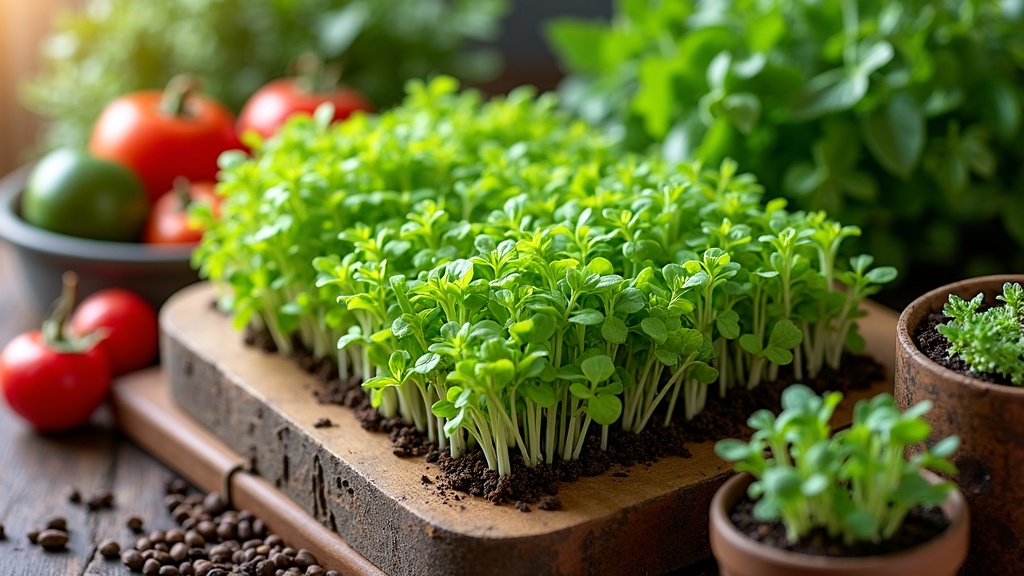Microgreens have become a favorite for gardeners, chefs, and anyone interested in healthy eating. Even though these tiny plants look like sprouts, they’re actually seedlings of veggies and herbs harvested just after they get their first true leaves. They come in all sorts of varieties, including broccoli, sunflower, radish, arugula, and pea shoots. I’m always amazed by how much flavor and nutrition they pack into such a small package. Here’s a breakdown of why microgreens are worth a spot on your plate, even if you’re new to growing your own food or mixing up your meals.

What Makes Microgreens Special?
Microgreens have been popping up everywhere, from grocery store shelves to farmers markets and even fancy restaurant dishes. I first gave them a try because I wanted to squeeze more vitamins into my lunches, and I kept reaching for them thanks to the taste. Each variety brings something unique: spicy radish, earthy beet, or nutty sunflower. They’re not just about bold flavor, though. Their tiny leaves and stems are loaded with nutrients—sometimes much more than their fullgrown versions. That’s pretty impressive for plants picked when they’re barely two weeks old.
Research backs up all the buzz. Studies from the USDA show that, ounce for ounce, microgreens can have up to 40 times higher levels of some vitamins and antioxidants compared to mature greens. So when chefs toss them on salads or sandwiches, they’re not just boosting looks or flavor, but nutrition too. Plus, since they’re harvested so early, microgreens don’t need as much space or time as other veggies. That’s a perk for anyone working with just a sunny window ledge or a small balcony.
The Nutritional Benefits of Microgreens
I’m always on the lookout for simple ways to supercharge my diet, and microgreens make that easy. Here’s what stands out when it comes to their nutrients:
- Vitamin Content: Microgreens are packed with vitamins C, E, and K. For example, red cabbage microgreens have loads of vitamin C, giving your immune system a welcome boost.
- Antioxidants: They are loaded with antioxidants, which help fight off damage from everyday stress and pollution. That means extra protection for your cells.
- Minerals: You’ll find handy amounts of potassium, iron, zinc, magnesium, and copper in many microgreens. These help with everything from keeping energy levels up to supporting healthy bones and blood.
- Phytonutrients: These natural compounds act as plant protectors and give you extra wellness perks, like anti-inflammatory effects and, in some cases, support for heart health.
I like using broccoli microgreens because they’re especially rich in sulforaphane, a phytonutrient linked to several health benefits, including helping with detoxing and reducing inflammation. Radish microgreens, meanwhile, supply a nice kick and antioxidant punch. They’re great for livening up a salad while looking after your health.
If you’re keen on getting a nutrition boost, try mixing your microgreens with regular greens. This gives you a wider array of nutrients, flavors, and textures. In addition, different colored microgreens bring different compounds with their own set of benefits, so it’s fun to switch things up regularly.
Growing Microgreens at Home
One of my favorite things about microgreens is how ridiculously easy they are to grow. I don’t need a big garden or fancy gear. Just a sunny window and a shallow container are enough. It only takes around 7 to 14 days from seed to harvest, which is super satisfying compared to waiting months for tomatoes or peppers.
- Pick your seeds: Choose what you’re excited to eat—sunflower, radish, pea, basil, or a mix works great for starters.
- Grab a shallow tray: Any foodsafe tray will work. Fill it with potting mix or use a special growing mat.
- Sow the seeds thickly: Sprinkle seeds in a single layer, then mist them to keep moist.
- Give them plenty of light: A sunny windowsill or a simple grow light does the trick.
- Harvest early: Once the first true leaves appear (about an inch tall), snip with scissors, rinse, and enjoy fresh.
Even with busy schedules, adding homegrown microgreens is doable. I’ve noticed they taste fresher than anything I buy at the store and really add a “wow” to even basic snacks.
If you want to get kids involved, let them pick seeds and watch them sprout. Microgreens are a fun indoor project that brings quick results, making healthy eating a bit more exciting for everyone involved.
Common Microgreen Varieties and Their Flavors
Every type of microgreen brings its own flavor, color, and texture, so it’s fun to mix and match. Here are a few that I use regularly:
- Sunflower: Mild, nutty, and crunchy. Awesome on avocado toast or as a salad base.
- Radish: Spicy and peppery. A great addon for wraps or Asian dishes.
- Pea shoots: Sweet with a nice snap. Perfect for sandwiches or stir fries at the last minute.
- Broccoli: Mild with a gentle crunch and loaded with sulforaphane.
- Red cabbage: Crisp, bright, and super high in vitamin C.
- Basil: Sweet, classic basil flavor. Nextlevel on pizza or in salads.
If you’re not sure where to start, I recommend trying a mix of sunflower and radish microgreens. Their flavors balance each other, and together they look pretty striking on the plate. You can keep things interesting by trying out new flavors every couple of weeks, tracking what you like most.
How to Use Microgreens in Everyday Meals
Adding microgreens to your meals doesn’t mean you have to completely change your routine. I throw them on just about anything for color, crunch, and a nutrition bonus.
- Sandwiches and Wraps: Use them instead of lettuce. They don’t get soggy and keep their crunch, plus they add that extra hit of flavor.
- Salads: Toss with other greens or use on their own with olive oil and vinegar.
- Soups: Sprinkle on hot or cold soups for a fresh finish and visual flair.
- Stir fries: Add at the very end, just before serving, to preserve texture.
- Egg Dishes: Pile microgreens on scrambled eggs, omelets, or frittatas.
- Bowls and Smoothies: Mix a handful into grain bowls, or blend mild varieties like spinach microgreens into smoothies for more nutrients without changing the flavor much.
There’s no need to overthink it. If it looks like it could use a pop of green and flavor, microgreens probably fit. They’ve even helped me get kids excited about eating plants. They like the fun size and variety of tastes.
Try exploring different flavor combinations, like pairing spicy radish microgreens with creamy avocado or tossing sweet pea microgreens into a citrus salad. The possibilities are endless!
Potential Challenges and Tips for Getting the Most Out of Microgreens
Even though microgreens are easy to grow and use, there are a couple of things to watch for.
- Shelf Life: Microgreens are delicate and don’t last as long as fullsized greens, especially after harvesting. Keeping them dry and in a sealed container in the fridge helps them last a few extra days, and harvesting only what you need means less waste.
- Food Safety: Use foodsafe trays and either fresh soil or a growing mat, since sprouts and seedlings can sometimes carry bacteria. Rinse before eating—a quick wash under cold water does the trick.
- Availability: Not all grocery stores stock microgreens, though they’re showing up more these days. Farmers markets, specialty grocers, or DIY growing are good bets.
Keeping things clean and harvesting as needed means fresher microgreens and a better experience overall. When I grow them on my own, I don’t worry about what might have been sprayed on them, and I get to pick the freshest batch every time. You can also try rotating the varieties you grow to match the seasons or your personal flavor preferences.
Handy Tips for Starting Your Microgreens Adventure
Here are a few lessons I’ve picked up while adding microgreens to my routine:
- Start with easy varieties like sunflower or radish. They sprout quickly and taste great raw, so you’ll see results and be more motivated to keep growing.
- Don’t crowd the seeds too much, or you’ll end up with mold or flimsy shoots. Aim for a thick but even layer so each seed gets light and space.
- A fine misting spray keeps seeds and sprouts moist without overwatering. Soggy soil can be a problem fast, so check your tray daily.
- If you’re short on sunlight, a simple grow light can make a huge difference. This helps keep your microgreens growing healthy and upright all year round.
- Harvest once they have the first pair of true leaves for the best flavor and nutrition. Waiting too long can make them tough, while harvesting too early means you’re missing out on their full nutrition content.
There’s something pretty cool about harvesting food from your window in the middle of winter. Even if you’re new to gardening, microgreens won’t make you feel lost—they’re genuinely userfriendly, and the payoff is quick. The whole process, from sowing seeds to enjoying them on your plate, can be a fun and satisfying routine.
Experiment by planting several small trays with different seeds at the same time. That way you’ll see which ones you like best, and you’ll always have something fresh coming up every few days. This also lets you try out new recipes and get creative with your meals.
Frequently Asked Questions About Microgreens
Question: Are microgreens safer than sprouts?
Answer: Microgreens are usually grown in soil or on mats and exposed to light, while sprouts are grown in water and harvested younger. This means microgreens tend to have a lower risk of bacterial contamination, especially if you rinse them before eating and use clean trays.
Question: How do microgreens compare to regular vegetables?
Answer: Microgreens often have higher concentrations of certain vitamins and phytonutrients than mature vegetables. They don’t replace vegetables completely, but they are a simple way to give your diet a nutrient upgrade.
Question: Can I grow microgreens year-round?
Answer: Yes! Since they only need a warm spot and a few hours of light, microgreens work even in wintertime. Just watch that they don’t dry out or get too cold if they’re next to drafty windows.
Question: What if my microgreens start to look leggy or pale?
Answer: Leggy or pale microgreens usually mean they need more light. Try moving them closer to a window or adding a small grow light. Also make sure you’re not overwatering or letting seeds sit in soggy conditions, as this can weaken the stems.
Try Microgreens for a Quick Nutrition Boost
Microgreens fit into nearly any lifestyle; they grow fast, taste great, and take almost no space. Whether you want to give your nutrition a boost, add bright flavors, or start playing with windowsill gardening, microgreens are a smart first step. I’ve found them to be one of the easiest ways to eat healthier, and I keep stumbling upon new ways to use them. If you’re curious, try growing a tray at home or picking up a box at the farmers market. With all their benefits, microgreens are definitely worth a spot in your kitchen—and they’re as fun to grow as they are to eat.


Leave a Reply